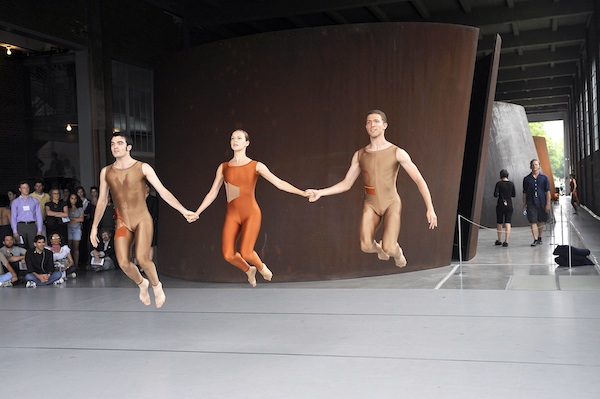
Inside the new Merce Cunningham app
By Melissa Harris, Aperture Foundation
Choreographer Merce Cunningham was adventurous, interested in working with new technology, and always thinking and acting ahead of his time. Toward the end of 1989, as part of his choreographic process, he began to use a computer program developed for him, then called LifeForms. His 1991 piece Trackers (the title inspired by the “tracking” function on the computer) was the first work he made utilizing this technology.
A 1997 photograph by artist Shelley Eshkar shows Cunningham looking on joyfully while two of the dancers in his troupe don reflective spheres to track their movements with optical sensors. Eshkar and his partner in digital artistry, Paul Kaiser, were introducing the choreographer to “motion capture” (from which derived their 1998 project with Cunningham Hand-Drawn Spaces, and the following year the dance BIPED—titled after a computer program by the same name designed for Cunningham). In the image, one can sense Cunningham’s sheer pleasure in the untried, in moving beyond his preconceptions; these were key concepts for the choreographer, as for his longtime collaborator, John Cage.
This image was one of the inspirations behind Aperture Foundation’s forthcoming app, Merce Cunningham: 65 Years. Created with the sponsorship of the Knight Foundation and in collaboration with the Cunningham Dance Foundation (CDF), the app is due to launch in mid-April of this year (not coincidentally, around the time of Cunningham’s birthday, and in conjunction with Aperture’s own sixtieth anniversary, as well as the centennial of Cage’s birth).
David Vaughan, archivist of the CDF, is the author of the acclaimed book Merce Cunningham: Fifty Years (Aperture, 1997), which chronicles the life and work of the choreographer through words, photographs, designs for sets and costumes, musical scores, choreographic notes, and much more. Greatly treasured in the Cunningham orbit and beyond, the book will now be transformed into a new iteration, the app, in which the choreographer, if he were alive, would surely have delighted. The text of Vaughan’s Fifty Years book has now been updated to include the final years of Cunningham’s life, and the entire text will be accessible digitally via the app. The app will also incorporate fifteen-second excerpts of dance footage (with sound)—selected by Vaughan, Trevor Carlson (executive director of the CDF), and others—from some forty dances performed over the span of Cunningham’s career. Also featured will be brief excerpts of interviews with Cunningham from writer/producer Nancy Dalva’s remarkable series “Mondays with Merce,” and a selection from Vaughan’s discussions with Cunningham made since the publication of Fifty Years—in this way the choreographer’s distinctive voice will be an integral part of the project. There will also be selections from Cunningham’s 2002 book Other Animals: Drawings and Journals (Aperture); a consideration of the Legacy Tour by Bonnie Brooks (CDF Legacy fellow); and additional photographs from 1994–2009. With the help of developer Larry Larson and designer Didier García, this app has been devised as an enduring, experiential project that will be truly of Merce Cunningham and his extraordinary work rather than simply about him.
Photographs are prominent in the app—including works by a wide spectrum of artists, from Aperture co-founder Barbara Morgan (who first photographed Cunningham in 1939, when he was still dancing with Martha Graham), James Klosty, Peter Hujar, and Robert Rauschenberg, right up to Stephanie Berger’s more recent images from “Beacon Events” (made in the last two years of Cunningham’s life, 2007–9). The app’s multimedia format also allows audiences to go beyond the still image; here they may engage in a variety of modes of experience and access to this invaluable material. In this especially, the app is very much in keeping with the spirit of Cunningham and his remarkable legacy.
Recent Content
-
Artsarticle ·
-
Artsarticle ·
-
Artsarticle ·

